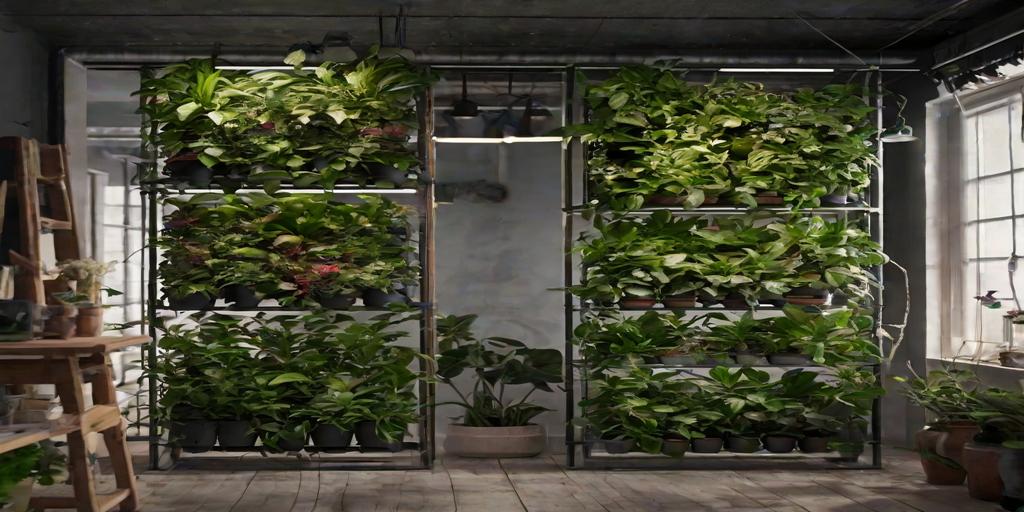
Space-Saving Vertical Gardens: Best Low-Light Hanging Plants for Small Spaces
Discover the best low-light hanging plants for space-saving vertical gardens! Perfect for small apartments, offices, or dim corners—bring greenery indoors without sacrificing style.
Introduction
Did you know that indoor plants can boost productivity by up to 15% and reduce stress? But what if you don’t have floor space or ample sunlight? That’s where space-saving vertical gardens come in! Whether you live in a tiny apartment or just want to maximize your greenery, low-light hanging plants are the perfect solution. In this guide, we’ll explore the best trailing, cascading, and air-purifying plants that thrive in dim conditions—no green thumb required!
Why Choose Vertical Gardens for Low-Light Spaces?
Benefits of Vertical Gardening for Small Spaces
If you’re tight on floor space but still want to bring greenery indoors, vertical gardens are a game-changer. They maximize unused wall space, making them perfect for apartments, offices, or any compact area. Plus, they create a stunning visual impact without cluttering your surfaces.
How Low-Light Plants Adapt to Indoor Conditions
Many houseplants have evolved to thrive in low-light environments, making them ideal for vertical setups in dim corners or rooms with few windows. These plants typically have larger, darker leaves that absorb light more efficiently, allowing them to grow steadily even in less-than-ideal conditions.
The Aesthetic and Functional Advantages of Hanging Plants
Vertical gardens aren’t just practical—they’re also incredibly stylish. Hanging plants add movement and life to a room, softening hard edges and creating a cozy, nature-inspired atmosphere. They can also improve air quality and even help reduce stress, making them a smart choice for both form and function.
Top Low-Light Hanging Plants for Vertical Gardens
Pothos (Epipremnum aureum) – Nearly Indestructible, Thrives in Low Light
Pothos is a beginner-friendly plant that can survive in almost any lighting condition, including low light. Its trailing vines grow quickly, making it perfect for hanging baskets or wall-mounted planters. Plus, it’s forgiving if you forget to water it occasionally.
Spider Plant (Chlorophytum comosum) – Purifies Air and Grows Effortlessly
Spider plants are not only easy to care for but also excellent air purifiers. They produce cascading baby spiderettes that can be propagated, giving you even more plants to fill your vertical garden. They do well in indirect light and only need moderate watering.
Philodendron Heartleaf – Fast-Growing with Beautiful Trailing Vines
With its heart-shaped leaves and rapid growth, the Heartleaf Philodendron is a great choice for adding lush greenery to your space. It thrives in low to medium light and can be trained to climb or left to trail elegantly from a hanging planter.
Peperomia – Compact and Ideal for Small Hanging Planters
Peperomia varieties, like the Watermelon or Ripple Peperomia, are small but mighty. Their compact size makes them perfect for tiny hanging pots, and their unique leaf patterns add texture to your vertical garden. They prefer bright, indirect light but can tolerate lower light levels.
Ferns (Boston, Maidenhair) – Love Humidity and Indirect Light
Ferns bring a delicate, feathery look to vertical gardens. Boston Ferns and Maidenhair Ferns thrive in humid, low-light environments, making them great for bathrooms or kitchens. Just keep their soil consistently moist, and they’ll reward you with lush, green fronds.
How to Set Up a Vertical Garden in Low-Light Areas
Choosing the Right Wall-Mounted or Hanging Planters
When setting up a vertical garden, opt for lightweight planters with good drainage. Wall-mounted pockets, macramé hangers, or tiered shelves work well. Ensure they’re sturdy enough to hold the weight of your plants, especially as they grow.
Best Soil and Drainage Practices for Healthy Growth
Use a well-draining potting mix to prevent waterlogged roots—a common issue in low-light conditions. Adding perlite or orchid bark can improve aeration. If your planters don’t have drainage holes, layer pebbles at the bottom to help excess water escape.
Creative DIY Vertical Garden Ideas for Tight Spaces
Get crafty with repurposed materials! Try using:
-
Old wooden pallets with plant pockets
-
Hanging shoe organizers for a budget-friendly option
-
Wall-mounted mason jars for small plants like air plants or succulents
Tips for Arranging Plants for Optimal Light Exposure
Place taller or bushier plants at the top of your vertical garden, where they can catch more light, and let trailing varieties hang below. Rotate your plants occasionally to ensure even growth, especially if one side receives slightly more light.
Caring for Your Low-Light Hanging Plants
Watering Schedules to Prevent Root Rot
Low-light plants typically need less water because they grow slower and evaporate moisture less quickly. Check the soil before watering—stick your finger an inch deep; if it’s dry, it’s time to water. Overwatering is the fastest way to kill these plants, so err on the side of underwatering.
Fertilizing Tips for Slow-Growing Plants
Since low-light plants grow at a slower pace, they don’t need frequent fertilizing. A diluted, balanced liquid fertilizer every 2-3 months during the growing season (spring and summer) is usually sufficient. Avoid fertilizing in winter when growth naturally slows.
Pruning and Training Vines for a Lush Look
Regular pruning keeps your plants looking full and prevents leggy growth. Trim back overgrown vines and pinch off yellowing leaves. For climbing plants like Pothos or Philodendron, use small hooks or trellises to guide their growth and create a fuller display.
Common Problems (Yellow Leaves, Pests) and Solutions
-
Yellow leaves: Often a sign of overwatering or poor drainage. Adjust your watering schedule and check soil moisture.
-
Pests: Spider mites and mealybugs can be an issue. Wipe leaves with a damp cloth or use neem oil for treatment.
-
Leggy growth: If your plant stretches toward light, it may need a slightly brighter spot (but still indirect).
Styling Tips for Vertical Gardens in Small Spaces
Mixing Textures and Colors for Visual Appeal
Combine plants with different leaf shapes and shades for a dynamic look. Pair the glossy leaves of Pothos with the soft fronds of a fern or the patterned foliage of a Peperomia for contrast.
Using Macramé Hangers, Shelves, and Trellises
Macramé hangers add bohemian charm, while floating shelves create a modern, organized display. Trellises can support climbing plants and add height to your arrangement.
Pairing Plants with Different Growth Habits for Depth
Mix trailing plants (like Spider Plants) with upright growers (like Snake Plants) to create layers. This adds dimension and makes your vertical garden look fuller.
Best Spots in Your Home for Low-Light Vertical Gardens
-
Bathrooms: The humidity helps ferns and other moisture-loving plants thrive.
-
Hallways: Often neglected, these spaces benefit from the life that hanging plants bring.
-
North-facing windows: These provide consistent, gentle light that won’t scorch delicate leaves.
By following these tips, you can create a thriving, beautiful vertical garden—even in the dimmest corners of your home.
Conclusion
Vertical gardens with low-light hanging plants are a game-changer for small spaces! From air-purifying pothos to elegant ferns, there’s a perfect plant for every dim corner. Ready to transform your space? Start with a few easy-care varieties and watch your indoor jungle thrive—even without direct sunlight.
